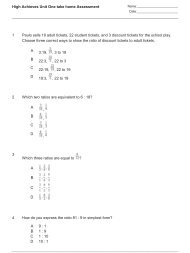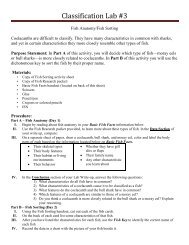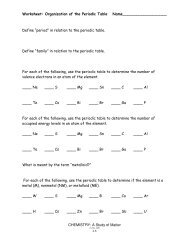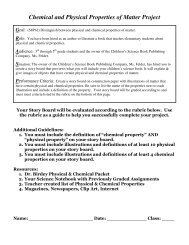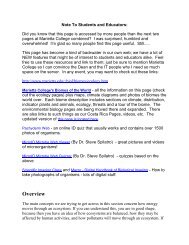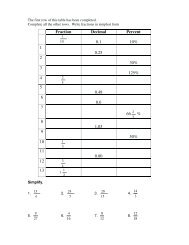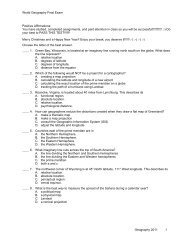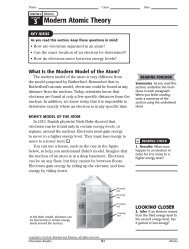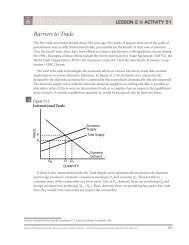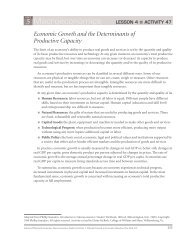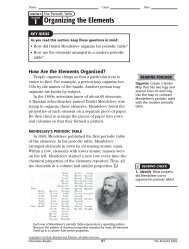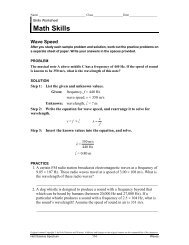1 Macroeconomics
1 Macroeconomics
1 Macroeconomics
You also want an ePaper? Increase the reach of your titles
YUMPU automatically turns print PDFs into web optimized ePapers that Google loves.
UNIT1 <strong>Macroeconomics</strong> LESSON 1 ■ ACTIVITY 2Opportunity Cost and Comparative AdvantagePeople who don’t know much about economics often dismiss economics as being little more thancost/benefit analysis. While it is true that this is a very important concept, economics is not that simple.In fact, one of the most difficult concepts in economics is understanding the opportunity cost ofchoosing a particular action.We have seen that economic entities such as countries often face increasing opportunity costs as they tryto increase production. For instance, when a country finds itself at war and needs to increase its productionof armaments, at first it finds that increasing military production comes at a relatively low opportunitycost, as the first factories converted to military use are generally well-suited for such an event.As the war goes on, however, we see factories that are not at all well-suited to producing weaponsbeing converted to military use, at a very high opportunity cost. Little is added to the output of armaments,and a great deal is sacrificed in terms of consumer goods.The notion of increasing opportunity costs is manifested in a production possibilities curve that isconcave towards the origin. In Figure 2.1, we can see that as we increase the production of military goods,each additional unit of output costs more in terms of civilian goods. When the government initiallyFigure 2.1Production Possibilities Curve: Military and Civilian Goods90MILITARY GOODS IN BILLIONS OF DOLLARS8070605040302010050100150200250300350400450500550600650660700CIVILIAN GOODS IN BILLIONS OF DOLLARSActivity written by Ike Brannon, Joint Economic Committee, U.S. Senate, Washington, D.C.Advanced Placement Economics <strong>Macroeconomics</strong>: Student Activities © National Council on Economic Education, New York, N.Y. 9
UNIT1 <strong>Macroeconomics</strong> LESSON 1 ■ ACTIVITY 2 (continued)increases the output of military goods from $20 billion to $30 billion, the opportunity cost (in terms ofcivilian goods forgone) is small: only $10 billion of military goods ($660 billion minus $650 billion).However, when the country is already producing a lot of military goods and wants to produce evenmore, the cost is much higher. If the country is producing $70 billion and wants to produce $80 billion,the opportunity cost is now $200 billion, or $600 billion minus $400 billion.Opportunity cost also explains the incredible amount of trade that goes on among individuals, firmsand countries. Today, of course, few of us produce our own goods and services; we rely on others to dothis while we use our time earning money at a job. Instead of making our goods, we buy them. Computermanufacturers actually produce few of their own parts, but instead buy parts from suppliers.Countries tend to specialize in the production of goods and services as well; for instance, therearen’t any firms in the United States currently making television sets, and we make very fewconsumer electronics of any sort. Instead, our businesses concentrate on making other goods andservices, and we import the televisions we need.As we will see, we benefit from trade with other countries even if we are better at producing everythingthan the other country. Trade will benefit both countries as long as we each specialize in doingthe task for which we have a lower opportunity cost. This is called comparative advantage.Part A: ExamplesLet’s begin with a simple example. One summer two friends, Ty and Jessica, each started a business,making money by providing lawn-care services. Although they earned decent money working alone,they wondered if they could make more money by working together. The table below shows howmany minutes it takes for each to complete the two tasks involved in doing one lawn: mowing andtrimming, which includes the sweeping, edging and cleanup.MowTrimTy 60 minutes 40 minutesJessica 75 minutes 90 minutesSomeone who can do an activity using fewer resources is said to have an absolute advantage. Ty hasan absolute advantage at both activities. Does this mean he should continue working alone?If your instinct is to say that Ty should not partner with Jessica, you are wrong, but you are in goodcompany: Adam Smith, whom many regard as the founder of modern economics, thought the samething. It wasn’t until David Ricardo came along in the early 1800s that people realized specializationand trade can benefit everyone even if one of the parties has an absolute advantage at both activities!If Ty and Jessica are going to specialize, who should do what? Now, absolute advantage does nottell us anything, since Ty is better at both things. Instead, we have to look at comparative advantage.We say someone has a comparative advantage at a task if this person can do the task at a loweropportunity cost than the other person.Here, the opportunity cost of Ty mowing a lawn is how much of a lawn he could have trimmed inthe same time. In this case, Ty could have used the 60 minutes it takes him to mow one lawn and hecould have trimmed 11/ 2 lawns, or 3/ 2 lawns.10 Advanced Placement Economics <strong>Macroeconomics</strong>: Student Activities © National Council on Economic Education, New York, N.Y.
UNIT1 <strong>Macroeconomics</strong> LESSON 1 ■ ACTIVITY 2 (continued)For Jessica, the opportunity cost of mowing one lawn is what she could have trimmed during the 75minutes she needed to mow that lawn. Jessica could have trimmed only 5/ 6 (or 75/ 90 ) of a lawn. Thus, wecan see that Jessica has a comparative advantage in mowing lawns because Jessica’s opportunity cost ofmowing a lawn is lower than Ty’s: Five-sixths of a lawn trimmed is less than 3/ 2 lawns trimmed.Now, we can calculate their opportunity cost to trim lawns. It takes Ty 40 minutes to trim onelawn, and with these 40 minutes he could instead have mowed 2/ 3 of a lawn (or 40/ 60 ). For Jessica,instead of using 90 minutes to trim one lawn, she could have spent these 90 minutes mowing onelawn and 1/ 5 of another lawn (90/ 75 ). Thus, Ty has a comparative advantage in trimming lawns. Thetable below shows the relative opportunity costs.Opportunity cost ofmowing one lawnOpportunity cost oftrimming one lawnTy 3/ 2 lawn trimmed 2/ 3 lawn mowedJessica 5/ 6 lawn trimmed 6/ 5 lawn mowedNotice two things about our calculation of opportunity cost: First, Ty’s opportunity cost of mowingone lawn (3/ 2 lawns trimmed) is the reciprocal of his opportunity cost of trimming one lawn (2/ 3 ). Thiswill always be true, so in this example we did twice as much math as we would normally have to.Second, notice that each person has a comparative advantage in precisely one activity. Unless aperson is equally able at both activities, this will always be true as well.Next, let’s see whether this specialization actually increases their productivity. Before specializing, itwould take Jessica 165 minutes (90 + 75) to mow and trim one lawn and Ty 100 minutes (60 + 40) tomow and trim one lawn, for a total of 265 minutes. If Jessica mows two lawns and Ty trims two lawns,then the total time needed to do two lawns would be 150 (75 x 2) + 80 (40 x 2) minutes or 230 minutes.Thus, they save 35 minutes, or 13 percent of the total time necessary to do the lawns without specializing.Together, they can do more lawns in a week, and they can split the additional income so both are richer.Let’s look at one more example. Here, we will express the relative productivity of each person not in thenumber of minutes they need to do the activity but instead in how many activities they can do in an hour.A few years ago Mark and Doreen were earning extra money installing car stereos for a local electronicsstore when they decided to go into business for themselves. After they rented a garage, theyhad to decide who should do what activity. The table below describes their productivity in the numberof stereos and speakers installed per hour.MarkDoreenRadios installed 6 10Speakers installed 2 5The table below contains the breakdown of the opportunity cost for each person to do each activity.MarkDoreenInstalling 1 radio 1/ 3 speaker 1/ 2 speakerInstalling 1 speaker 3 radios 2 radiosMark has the comparative advantage in installing radios, and Doreen has the comparative advantagein installing speakers. By specializing, their total output increases.Advanced Placement Economics <strong>Macroeconomics</strong>: Student Activities © National Council on Economic Education, New York, N.Y. 11
UNIT1 <strong>Macroeconomics</strong> LESSON 1 ■ ACTIVITY 2 (continued)Part B: Questions1. What is the difference between comparative advantage and absolute advantage?2. You’re given the following information about a newlywed couple and the time it takes each ofthem to do two different chores: vacuuming a room or washing a load of dishes.MikeDebbieVacuum a room 60 minutes 45 minutesWash a load of dishes 30 minutes 45 minutes(A) What is Mike’s opportunity cost of vacuuming in terms of washing dishes?(B) What is Mike’s opportunity cost of washing dishes in terms of vacuuming?(C) What is Debbie’s opportunity cost of vacuuming in terms of washing dishes?(D) What is Debbie’s opportunity cost of washing dishes in terms of vacuuming?(E) Who has the absolute advantage in vacuuming? ___________________________(F) Who has the absolute advantage in washing dishes? ________________________(G) Who has the comparative advantage in vacuuming? _______________________(H) Who has the comparative advantage in washing dishes? ____________________(I) Who should do which chore and why? Base your answer only on the information above andon comparative advantage considerations.12 Advanced Placement Economics <strong>Macroeconomics</strong>: Student Activities © National Council on Economic Education, New York, N.Y.
UNIT1 <strong>Macroeconomics</strong> LESSON 1 ■ ACTIVITY 2 (continued)3. Now, you’re given the following information about Andy and Hannah and the time it takes each ofthem to clean an office and clean a jail cell:AndyHannahCleaning offices 60 minutes 20 minutesCleaning jail cells 30 minutes 15 minutes(A) What is Andy’s opportunity cost of cleaning offices in terms of cleaning jail cells?(B) What is Hannah’s opportunity cost of cleaning offices in terms of cleaning jail cells?(C) What is Andy’s opportunity cost of cleaning jail cells in terms of cleaning offices?(D) What is Hannah’s opportunity cost of cleaning jail cells in terms of cleaning offices?(E) Who has the absolute advantage in cleaning offices? ___________________________(F) Who has the absolute advantage in cleaning jail cells? ___________________________(G) Who has the comparative advantage in cleaning offices? ___________________________(H) Who has the comparative advantage in cleaning jail cells? ___________________________(I) Who should do which chore and why? Base your answer only on the information above andon comparative advantage considerations.4. Consider the following two countries. Assume they produce only these two goods. Note that productivityis now measured in how many goods can be produced per hour, the opposite of how wemeasured it in Questions 2 and 3.United StatesJapanCars 12 10Computers 4 6(A) What is the United States’ opportunity cost of making cars?Advanced Placement Economics <strong>Macroeconomics</strong>: Student Activities © National Council on Economic Education, New York, N.Y. 13
UNIT1 <strong>Macroeconomics</strong> LESSON 1 ■ ACTIVITY 2 (continued)(B) What is Japan’s opportunity cost of making cars?(C) What is the United States’ opportunity cost of making computers?(D) What is Japan’s opportunity cost of making computers?(E) Which country has the absolute advantage in cars? __________________________(F) Which country has the absolute advantage in computers? __________________________(G) Which country has the comparative advantage in cars? __________________________(H) Which country has the comparative advantage in computers? __________________________(I) Which country should produce which good and why? Base your answer only on the informationabove and on comparative advantage considerations.5. Use the law of comparative advantage to explain why self-sufficiency leads to a lower standard ofliving.14 Advanced Placement Economics <strong>Macroeconomics</strong>: Student Activities © National Council on Economic Education, New York, N.Y.



